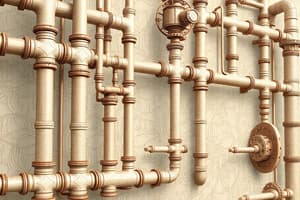Podcast
Questions and Answers
What is the primary goal of piping layout design?
What is the primary goal of piping layout design?
- To optimize piping layout for efficient fluid flow, minimal pressure drop, and ease of maintenance (correct)
- To ensure pipes are easily accessible for maintenance
- To maximize pipe lengths and quantities
- To minimize pipe material costs
What is the primary purpose of piping codes?
What is the primary purpose of piping codes?
- To standardize pipe sizes and fittings
- To regulate piping installation costs
- To provide guidelines for pipe material selection
- To ensure safety and reliability in piping systems (correct)
Which of the following is NOT a key consideration in piping layout design?
Which of the following is NOT a key consideration in piping layout design?
- Electrical wiring and cabling (correct)
- Space constraints and accessibility
- Pipe sizing and routing
- Support and anchoring systems
Which piping material is known for its high corrosion resistance?
Which piping material is known for its high corrosion resistance?
What is a key factor in selecting piping materials?
What is a key factor in selecting piping materials?
Which piping code is specifically relevant to pipeline transportation systems?
Which piping code is specifically relevant to pipeline transportation systems?
Flashcards are hidden until you start studying
Study Notes
Piping Design
Piping Layout
- Goal: Optimize piping layout for efficient fluid flow, minimal pressure drop, and ease of maintenance
- Key considerations:
- Space constraints and accessibility
- Pipe sizing and routing
- Support and anchoring systems
- Insulation and heat tracing
- Drainage and venting
- Layout principles:
- Keep pipes short and direct
- Avoid unnecessary bends and fittings
- Group similar pipes together
- Use standardized pipe sizes and fittings
Piping Codes
- Definition: Regulations and standards governing piping design, fabrication, and installation
- Examples of piping codes:
- ASME B31.1 (Power Piping)
- ASME B31.3 (Process Piping)
- ASME B31.4 (Pipeline Transportation Systems)
- API 650 (Welded Steel Tanks for Oil Storage)
- Purpose:
- Ensure safety and reliability
- Provide guidelines for material selection, fabrication, and testing
- Establish minimum requirements for piping systems
Material Selection
- Factors influencing material selection:
- Fluid properties (temperature, pressure, corrosiveness)
- Environmental conditions (ambient temperature, humidity)
- Cost and availability
- Code requirements and regulations
- Common piping materials:
- Carbon steel (CS)
- Stainless steel (SS)
- Aluminum (Al)
- Copper (Cu)
- Polyvinyl chloride (PVC)
- Polyethylene (PE)
- Material selection considerations:
- Corrosion resistance
- Strength and ductility
- Thermal conductivity and expansion
- Weldability and formability
- Compatibility with fluids and environment
Piping Design
Piping Layout
- Optimize piping layout for efficient fluid flow, minimal pressure drop, and ease of maintenance by considering space constraints and accessibility.
- Pipe sizing and routing are crucial to ensure efficient fluid flow and minimal pressure drop.
- Support and anchoring systems are necessary to prevent pipe damage and ensure stability.
- Insulation and heat tracing are essential for maintaining optimal fluid temperatures and preventing corrosion.
- Drainage and venting are critical for removing air and fluid pockets that can affect system performance.
Piping Layout Principles
- Keep pipes short and direct to reduce pressure drop and fluid flow resistance.
- Avoid unnecessary bends and fittings to minimize turbulence and pressure drop.
- Group similar pipes together to simplify maintenance and reduce costs.
- Use standardized pipe sizes and fittings to ensure compatibility and ease of replacement.
Piping Codes
- Piping codes are regulations and standards governing piping design, fabrication, and installation.
- Examples of piping codes include ASME B31.1, ASME B31.3, ASME B31.4, and API 650.
- Piping codes ensure safety and reliability by providing guidelines for material selection, fabrication, and testing.
- Piping codes establish minimum requirements for piping systems to prevent accidents and ensure compliance.
Material Selection
- Fluid properties (temperature, pressure, corrosiveness) influence material selection for piping systems.
- Environmental conditions (ambient temperature, humidity) affect material selection and performance.
- Cost and availability are significant factors in material selection, along with code requirements and regulations.
- Common piping materials include carbon steel, stainless steel, aluminum, copper, PVC, and polyethylene.
- Material selection considerations include corrosion resistance, strength and ductility, thermal conductivity and expansion, weldability and formability, and compatibility with fluids and environment.
Studying That Suits You
Use AI to generate personalized quizzes and flashcards to suit your learning preferences.



